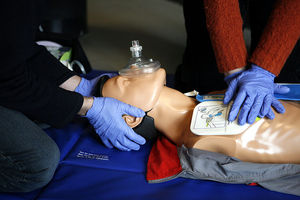What Is Endotracheal Intubation?
The trachea is the windpipe and “intubation” refers to the insertion of a tube; endotracheal intubation is, therefore, the insertion of a tube into the trachea. Another term closely associated with this advanced life support (ALS) procedure is orotracheal intubation. “Oro” refers to the mouth and the terms is used to refer specifically to the placement of an endotracheal tube via the mouth.
Why Is Endotracheal Intubation Performed?
Hands-only cardiopulmonary resuscitation (CPR) is a fairly new method of CPR to be performed by laypeople who aren’t trained in the CPR performed by health care providers such as emergency medical technicians (EMT’s) of all levels and paramedics. Obviously, the hands-only method excludes providing artificial respiration, also called ventilation, for the apneic (totally non-breathing) victim. Instead, only chest compressions are done until emergency medical services (EMS) arrive. Cardiac arrest or the stoppage of the heart beat and respiratory arrest or the complete cessation of breathing are closely related; the one depends on the other. If the heart stops first, respirations will soon follow, and if respirations are arrested, the heart will soon cease to beat; it needs oxygen like any other part of the body in order to keep functioning. This is why conventional and health care provider level CPR focuses on airway management and artificial respiration as well.
Endotracheal intubation is not always done even on the apneic patient because it isn’t always necessary. There are very dangerous–life threatening complications that can occur with this procedure, complications in which the average layperson would not be interested. The advantages, however, are significant and can be interesting. Imagine a person in respiratory arrest and time ticking away; every second is important because of the brain damage and even the death of the brain that can occur within a matter of minutes. Orotracheal intubation is a life-saving medical technique because the endotracheal tube, commonly referred to as an ET tube is placed directly and deep into the trachea (windpipe) which extends down through both lungs. The trachea branches off to the right and to the left; this makes sense as there are two lungs. These branches are called the right and the left main bronchus respectively (“bronchi” is the plural of bronchus). The point at which the trachea begins to branch is called the “carina.” During endotracheal intubation, the ET tube is advanced to the point where it is close to the carina.
This type of advanced airway management allows for life-saving oxygen to be delivered directly into both lungs. Among some of the indications (reasons) for performing endotracheal intubation are an inability to ventilate an apneic victim and cardiac arrest. This is definitely an invasive procedure to which some risk is attached, and it’s not a very pretty sight to see, or at least it wasn’t for me the first time I saw it performed in the emergency room during my clinicals. However, correctly performed, it is among the most important emergency medical techniques in airway management used to save lives.
Source:
My EMT training (state licensed, NREMT certification)
